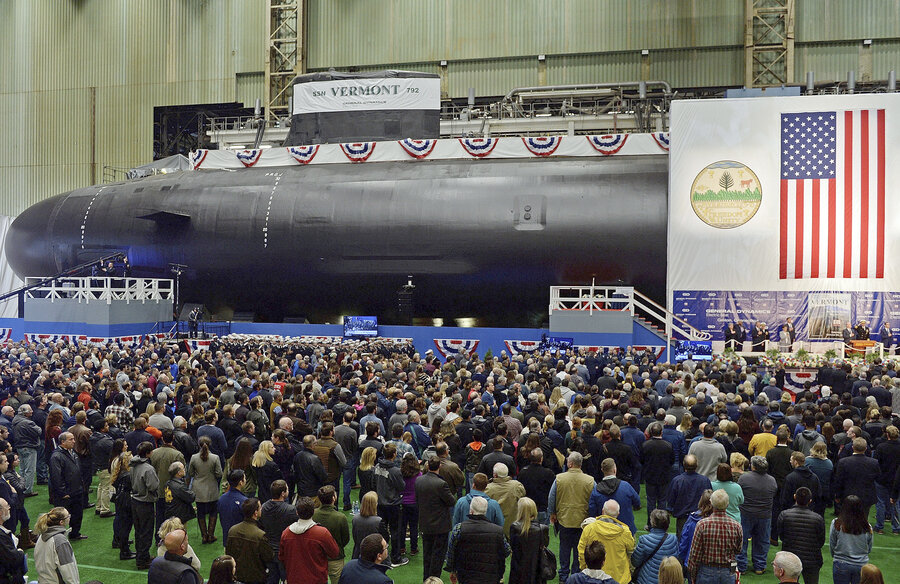Pacific deterrence: US sends nuclear submarines to South Korea
Loading...
| Washington
Presidents Joe Biden and Yoon Suk Yeol on Wednesday will sign an agreement that includes plans to have U.S. nuclear-armed submarines dock in South Korea for the first time in more than 40 years, a conspicuous show of support to Seoul amid growing concern about nuclear threats by North Korea, according to senior Biden administration officials.
The planned dock visits are a key element of what’s being dubbed the “Washington Declaration,” aimed at deterring North Korea from carrying out an attack on its neighbor. It is being unveiled as Mr. Biden is hosting Mr. Yoon for a state visit during a moment of heightened anxiety for both leaders over an increased pace of ballistic missile tests by North Korea over the last several months.
The three senior Biden administration officials, who briefed reporters on the condition of anonymity ahead of the official announcement, said that Mr. Biden’s and Mr. Yoon’s aides have been working on details of the plan for months and agreed that “occasional” and “very clear demonstrations of the strength” of U.S. extended deterrence capabilities needed to be an essential aspect of the agreement.
The agreement seeks to allay South Korean fears over the North’s aggressive nuclear weapons program and to ward off the country from restarting its own nuclear program, which it gave up nearly 50 years ago when it signed the Nuclear Non-Proliferation Treaty. The United States and South Korea also would coordinate more deeply on nuclear response strategy in the event of the North attacking the South – but operational control of such weapons would remain in U.S. control, and no nuclear weapons are being deployed onto South Korean shores.
The agreement also calls for the U.S. and South Korean militaries to strengthen joint training and better integrate South Korean military assets into the joint strategic deterrence effort. As part of the declaration, South Korea will reaffirm its commitment to the Nuclear Non-Proliferation Treaty, an agreement signed by several major nuclear and non-nuclear powers that pledged their cooperation to stem the spread of nuclear technology, the officials said.
As a candidate for the presidency last year, Mr. Yoon said he would call for the increased deployment of U.S. bombers, aircraft carriers, and nuclear submarines to South Korea as he looked to offer a firmer response to the North’s threats than his predecessor Moon Jae-in.
In the midst of the Cold War in the late 1970s, U.S. nuclear-armed ballistic missile submarines made frequent port visits to South Korea, sometimes two to three visits per month, according to the Federation of American Scientists. It was a period when the U.S. had hundreds of nuclear warheads located in South Korea.
But in 1991, the U.S. withdrew all of its nuclear weapons from the Korean Peninsula, and the following year Seoul and Pyongyang signed a joint declaration pledging that neither would “test, manufacture, produce, receive, possess, store, deploy, or use nuclear weapons.” But as the North has repeatedly violated the joint declaration over the years, there’s been increased support in South Korea for the U.S. to return nuclear weapons to the country.
One Biden administration official cautioned it is “crystal clear” that there are no plans by the administration for “returning tactical or any other kind of nuclear weapon to the Korean Peninsula.” Instead, administration officials said they envision that the visit of ballistic missile submarines will be followed by the U.S. military more regularly deploying assets such as bombers or aircraft carriers to South Korea.
North Korea’s increasing nuclear threats, along with concerns about China’s military and economic assertiveness in the region, have pushed the Biden administration to expand its Asian alliance. To that end, Mr. Biden has thrown plenty of attention at Mr. Yoon as well as Japanese Prime Minister Fumio Kishida. Next week, Mr. Biden will host Philippine President Ferdinand Marcos Jr. for Oval Office talks.
In the past year, North Korea has been steadily expanding its nuclear arsenal, while China and Russia repeatedly block U.S.-led efforts to toughen sanctions on the North over its barrage of banned missile tests.
The stepped-up testing by North Korea includes the flight-testing of a solid-fuel intercontinental ballistic missile for the first time earlier this month. The recent test is seen as a possible breakthrough in the North’s efforts to acquire a more powerful, harder-to-detect weapon targeting the continental United States.
Besides nuclear deterrence, Mr. Biden and Mr. Yoon, and their aides, also are expected to discuss Russia’s ongoing war in Ukraine. The Biden administration has praised South Korea for sending some $230 million in humanitarian aid to Kyiv, but Mr. Biden would welcome Seoul taking an even bigger role in helping the Ukrainians repel Russia.
Mr. Yoon’s visit comes just weeks after the leaks of scores of highly classified documents that have complicated relations with allies, including South Korea. The papers viewed by The Associated Press indicate that South Korea’s National Security Council “grappled” with the U.S. in early March over an American request to provide artillery ammunition to Ukraine.
The documents, which cited a signals intelligence report, said then-NSC Director Kim Sung-han suggested the possibility of selling the 330,000 rounds of 155 mm munitions to Poland, since getting the ammunition to Ukraine quickly was the United States’ ultimate goal.
One Biden administration official said that Mr. Biden planned to talk to Mr. Yoon about “what it means for all like-minded allies to continue to support Ukraine” and ask the South Korean leader “what the future of their support might look like.”
Besides their talks on Wednesday, Mr. Biden and Mr. Yoon are scheduled to host a joint news conference. In the evening, Biden and first lady Jill Biden will honor Mr. Yoon and his wife, Kim Keon Hee, for a state dinner at the White House.
This story was reported by The Associated Press.







